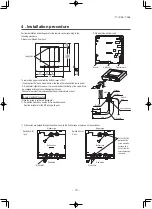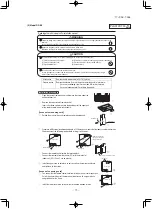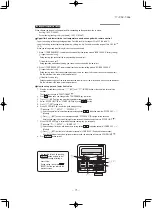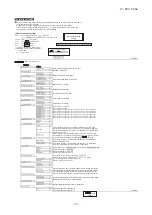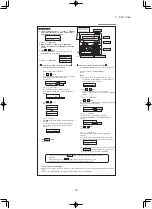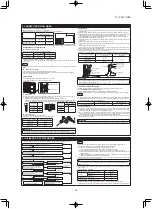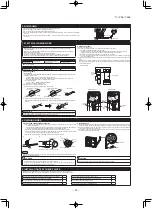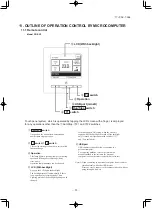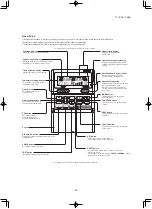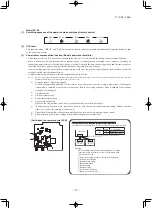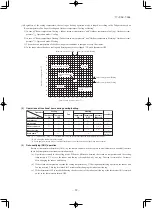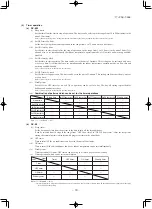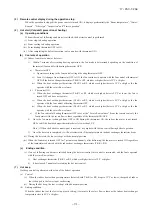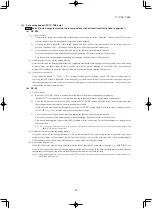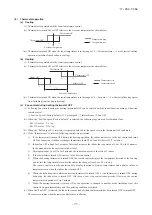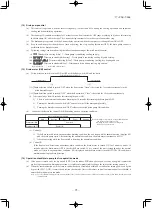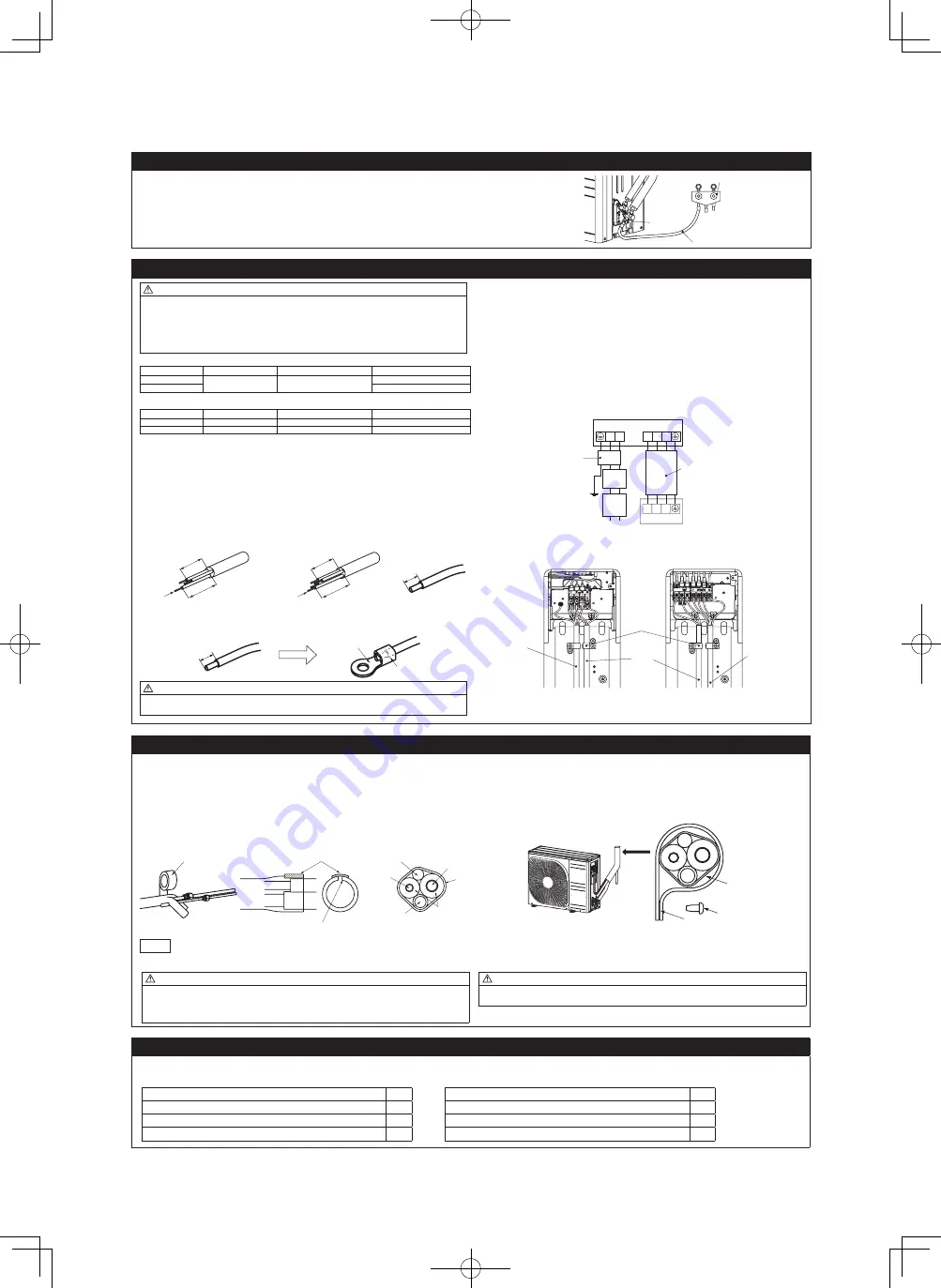
-
82
-
'17 • PAC-T-256
6. PUMP DOWN
(1) Connect charge hose of gauge manifold to service port of outdoor unit.
(2) Close the liquid service valve with hexagonal wrench key.
(3) Fully open the gas service valve with hexagonal wrench key.
(4) Carry out forced cooling operation (For forced cooling operation procedure, refer to indoor unit installation
manual).
(5) When the low pressure gauge becomes 0.01MPa, close the gas service valve and stop forced cooling
operation.
Service port
Gauge manifold
Charge hose
7. ELECTRICAL WIRING WORK
WARNING
• Make sure that all the electrical work is carried out in accordance with the national or regional
electrical standards.
• Make sure that the earth leakage breaker and circuit breaker of appropriate capacities are installed
(Refer to the table given below).
• Do not turn on the power until the electrical work is completed.
• Do not use a condensive capacitor for power factor improvement under any circumstances.
(It does not improve power factor. Moreover, it can cause an abnormal overheat accident).
Breaker specifications
Model
Phase
Earth leakage breaker
Circuit breaker
SRC20/25/35
Single phase
Leakage current: 30mA,
0.1sec or less
Over current: 16A
SRC40/50/60
Over current: 20A
Main fuse specification
Model
Specification
Parts No.
Code on LABEL,WIRING
SRC20/25/35
250V 15A
SSA564A136
F4
SRC40/50/60
250V 20A
SSA564A136A
F4
1.Preparing cable
(1) Selecting cable
Select the power source cable and connecting cable in accordance with the specifications mentioned below.
(a) Power source cable
3 cores* 2.0mm
2
or more, conformed with 60245 IEC57
When selecting the power source cable length, make sure that voltage drop is less than 2%.
If the wire length gets longer, increase the wire diameter.
(b) Connecting cable
4 cores* 1.5mm
2
, conformed with 60245 IEC57
* 1 Earth wire is included (Yellow/Green).
(2) Arrange each wire length as shown below.
Make sure that each wire is stripped 10mm from the end.
<Power source cable>
<Connecting cable>
<Wire end>
Earth wire
40mm or more
30mm or more
40mm or more
Earth wire
30mm or more
10mm
(3) Attach round crimp-type terminal to each wire as shown in the below.
Select the size of round crimp-type terminal after considering the specifications of terminal block and wire
diameter.
10mm
Round crimp-type terminal
Sleeve
CAUTION
Power source cable and connecting cable must conform to the specifications mentioned in the manual.
Using cables with wrong specifications may result in unit malfunction.
2.Connecting cable
(1) Remove the service cover.
(2) Connect the cables according to the instructions and figures given below.
(a) Connect the earth wire of power source cable.
An earth wire must be connected before connecting the other wires of power source cable.
Keep the earth wire longer than the remaining two wires of power source cable.
(b) Connect the remaining two wires (N and L) of power source cable.
(c) Connect the wires of connecting cable. Make sure that for each wire, outdoor and indoor side
terminal numbers match.
(3) Fasten the cables properly with cable clamps so that no external force may work on terminal connec-
tions.
Moreover, make sure that cables do not touch the piping, etc. When cables are connected, make sure
that all electrical components within the electrical component box are free of loose connector coupling
or terminal connection.
<Circuit diagram>
N L
1 2/N 3
1 2/N 3
Circuit
breaker
Earth
leakage
breaker
Earth
Power
source
Indoor unit
Outdoor unit
Connecting cable
Power
source
cable
<SRC20/25/35>
<SRC40/50/60>
Power
source
cable
Connecting
cable
Connecting
cable
Cable clamp
8. FINISHING WORK
1. Heating and condensation prevention
(1) Dress the connecting pipes (both liquid and gas pipes) with insulation to prevent it from heating
and dew condensation.
Use the heat insulating material which can withstand 120°C or higher temperature. Make sure that
insulation is wrapped tightly around the pipes and no gap is left between them.
(2) Wrap the refrigerant pipings of indoor unit with indoor unit heat insulation using tape.
(3)
Cover the flare-connected joints (indoor side) with the indoor unit heat insulation and wrap it with
an insulation pad (standard accessory provided with indoor unit).
(4) Wrap the connecting pipes, connecting cable and drain hose with the tape.
(2)
(3)
(4)
Tape
Insulation pad
Position it so that the slit area faces upward.
Connecting cable
Liquid pipe
Drain hose
Gas pipe
Insulation
Tape
NOTE
Locations where relative humidity exceeds 70%, both liquid and gas pipes need to be dressed with 20mm or
thicker heat insulation materials.
2.Finishing work
(1) Make sure that the exterior portion of connecting pipes, connecting cable and drain hose is wrapped
properly with tape. Shape the connecting pipes to match with the contours of the pipe assembly route.
(2) Fix the pipe assembly with the wall using clamps and screws. Pipe assembly should be anchored
every 1.5m or less to isolate the vibration.
(3) Install the service cover securely. Water may enter the unit if service cover is not installed properly,
resulting in unit malfunction and failure.
Pipe assembly
Screw
Clamp
CAUTION
• Improper insulation can cause condensate(water) formation during cooling operation.
Condensate can leak or drip causing damage to household property.
• Poor heat insulating capacity can cause pipe outer surface to reach high temperature during heating
operation. It can cause cable deterioration and personal injury.
CAUTION
Make sure that the connecting pipes do not touch the components within the unit. If pipes touch the
internal components, it may generate abnormal sounds and/or vibrations.
9. INSTALLATION TEST CHECK POINTS
After finishing the installation work, check the following points again before turning on the power.
Conduct test run (Refer to indoor unit installation manual) and ensure that the unit operates properly.
Power source voltage complies with the rated voltage of air-conditioner.
Earth leakage breaker and circuit breaker are installed.
Power cable and connecting cable are securely fixed to the terminal block.
Both liquid and gas service valves are fully open.
No gas leaks from the joints of the service valves.
Indoor and outdoor side pipe joints have been insulated.
Drain hose (if installed) is fixed properly.
Screw of the service cover is tightened properly.



